R700: ATI Radeon HD 4870 X2 Review
R700: ATI Radeon HD 4870 X2
It's been a long time coming, but ATI finally hits the top spot again.

Verdict
Key Specifications
- Review Price: £399.49
ATI has been waiting a long time for this moment. nVidia has been dominating the top-end of the graphics card market for nearly two years now and, although ATI has come back strong with its competitively priced HD 4870 and HD 4850 products, there’s nothing quite like being able to claim the top spot.
Enter, then, the ATI HD 4870 X2 (codenamed R700), the fastest graphics card in the world. Well, that’s what ATI says – we’ll be putting these claims to the test later on. First, though, there’s a few details to get out the way.
As you may have guessed from the ‘X2’ on the end, this card uses the same performance boosting method employed by the HD 3870 X2. Namely, taking two graphics chips, slapping them on the same card and using the wonders of Crossfire to make them work together to increase the card’s overall performance. The big difference between this card and a standard dual card Crossfire/SLI solution is the fact that the X2 is platform independent so will work on any motherboard with a x16 PCI-Express slot, whether the chipset the motherboard uses is Intel, AMD, or nVidia.
Now one problem with this method of performance boosting is that it requires games and drivers to be written to take advantage of the two chips. This can lead to new or obscure games seeing little benefit from the second chip or even in the worst case scenarios lead to games not working at all. So, we were hoping that ATI might have come up with a magical way of making Crossfire on the HD 4870 X2 work seamlessly so performance and compatibility is consistent across all games. Unfortunately this isn’t the case so there are still all the potential pitfalls that have plagued multi-GPU solutions to consider before buying this card.
With that said, the reasons for buying this card are still very compelling. I mean, just look at the stats. 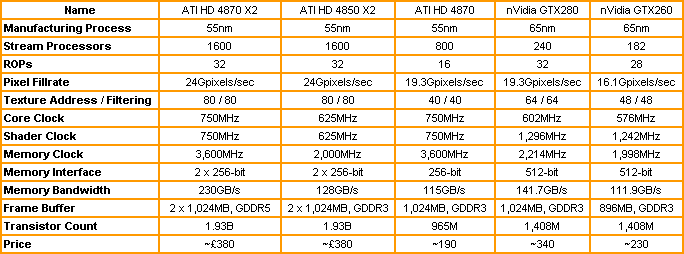
Need I say more?
Ok, I suppose I’d better.
Some of the crazy figures that result from strapping two RV770s (the codename of the chip used in the HD 4870) together really start to become meaningless – a theoretical 2.4TeraFLOPs of processing power is, as ATI is keen to point out, double the performance of the fastest super computer in the world in 1996. Cool, no doubt, but of little real world relevance. What is most important to note is despite the doubling up of most numbers, the HD 4870 X2 should only bring about 1.6 – 1.8 times the performance of a single HD 4870.
Also of significance is the inclusion of a whopping 1GB of frame buffer memory per chip for a total of 2GB for the card. ATI assures us that this extra RAM does bring a noticeable performance advantage, over using 512MB per chip, at the highest resolutions and AA settings. However, as we only have the 2GB card, this isn’t something we can test directly.
As well as the flagship HD 4870 X2 with 2GB of RAM there will also be a 1GB (2 x 512MB) card as well as two HD 4850 X2 cards, also with 1GB and 2GB frame buffers. Just like their none-X2 namesakes the HD 4850 X2 and HD 4870 X2 are differentiated by the type of memory they use with the former employing slower GDDR3 and the latter using super fast GDDR5.
Now, the 2GB frame buffer issue has some interesting consequences when using these cards in 32-bit operating systems, as this massive amount of memory will gobble up more than half of your computer’s address space, leaving less than 2GB for actually running programs. For the time being we’ve kept our testing to just 32-bit Vista but ideally you’d want to use a card like this with a 64-bit OS. 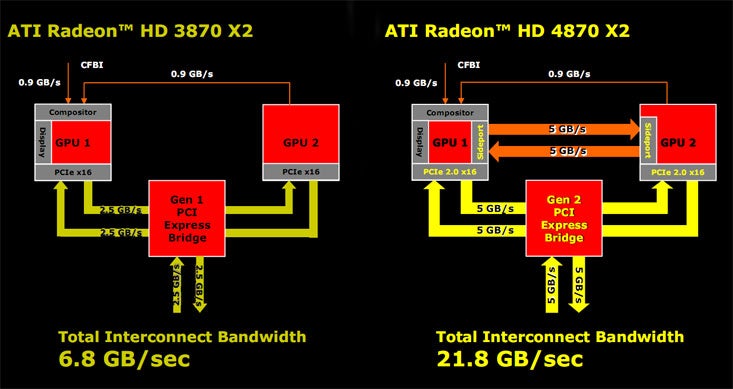
The only other notable features of the X2 all come in the way the two RV770 chips communicate. Just like the HD 3870 X2, the HD 4870 X2 uses a PCI-Express bridge chip to manage the majority of the communications but instead of being limited to PCI-Express 1.0, the new chip is PCI-Express 2.0 so bandwidth has doubled.
Not only that but ATI has also included a brand new feature called sideport. This is a dedicated connection between the two chips that provides an additional bi-directional 5GB/s of bandwidth. The result is a card that should never be left wanting when it comes to inter-chip communication.
Oddly, though, ATI hasn’t actually enabled sideport. We were told this is because it’s simply not needed yet and, in fact, may never be needed, so rather than dedicate driver development time to getting it working, ATI has left it unused.
Given the fact it crams in two chips, it should come as no surprise that the HD 4870 X2 is a whopper of a graphics card. At 270mm long, it is one of the longest graphics cards you can buy, though notably it’s only the same length as an nVidia GTX 280, a card which uses just one chip. 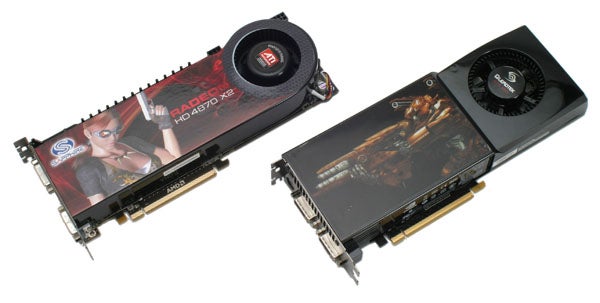
Probably the most striking thing about this card, though, is it’s weight. This has been something of a trend with ATI’s recent cards and is something we still haven’t got to the bottom of yet – for some reason nVidia is able to make its stock coolers considerably lighter than ATI’s. Not that this should be of much concern if you make sure the card is securely held in your case.
The cooler itself is a fairly typical design with a large centrifugal fan sucking in air from the front, blowing it across the heatsinks over the chips and exhausting it out the back. It works well, staying consistently quiet when not gaming and although very audible when going at full pelt, we would expect you to be wearing headphones at such points. Our only concern would be the same worry we had about the HD 4870 and HD 4850 cards. Namely, they do run very hot. Obviously ATI feels this isn’t to the detriment of the card and indeed we suffered no stability problems but you’ll need a very well ventilated case if you want one of these cards. 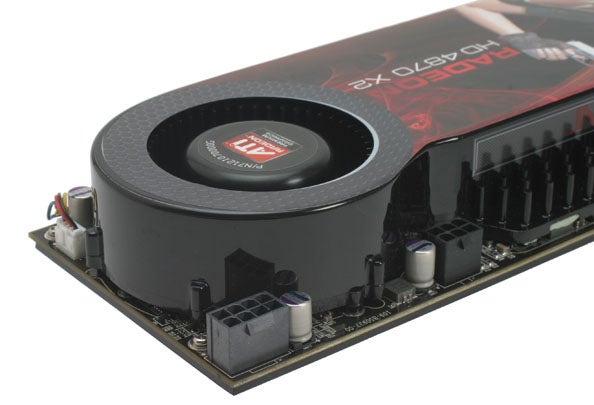
Taking a tour round the card we see the two auxiliary power connections along the top edge towards the back of the card. ATI has again chosen to mount these connectors perpendicular to the PCB, which we feel makes them more difficult to access than the conventional upwards facing connectors.
Due to its massive power draw, both connectors must be used for the card to even run. In fact at full pelt the card pulls a colossal 285 Watts so you’ll be wanting at least a 600W power supply to keep this card going. 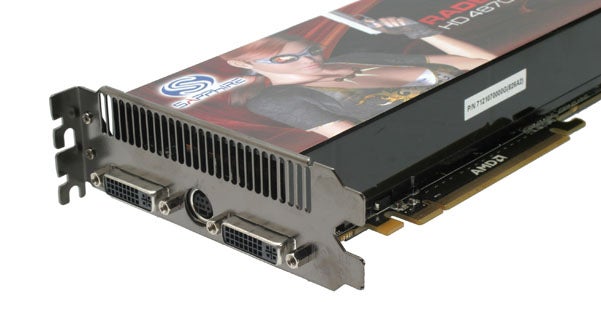
Output options are par for the course with a multi-output analogue socket nestled between two dual-link DVI outputs. The DVI sockets can be used in conjunction with DVI-to-HDMI and DVI-to-VGA converters and the former will allow you to pass a digital audio signal out to your TV or AV setup. Meanwhile the analogue connection support S-Video natively along with component and composite with the help of a provided dongle.
All our testing uses a variety of manual run throughs and automated timedemos, but regardless of which test method is used, we monitor all tests to ensure performance is consistent. Where there are spurious results or dips in performance we will note this. We also do multiple run throughs then take the average of these and report that figure to you. The test setup is as follows:
”’Common System Components”’
* Intel Core 2 Quad QX9770
* Asus P5E3
* 2GB Corsair TWIN3X2048-1333C9 DDR3
* 150GB Western Digital Raptor
* Microsoft Windows Vista Home Premium 32-bit
”’Drivers”’
* ATI Radeon HD 4870 X2:
* Other ATI Cards: Catalyst 8.4
* nVidia 9×00 series: Forceware 175.19
* nVidia GTX 2×0 series: Forceware 174.74
”’Cards Tested”’
* ATI HD 4870 X2
* ATI HD 4870
* ATI HD 4850
* nVidia GeForce GTX 280
* nVidia GeForce GTX 260
* nVidia GeForce 9800 GTX
”’Games Tested”’
* Crysis
* Race Driver: GRID
* Enemy Territory: Quake Wars
* Call of Duty 4
* Counter-Strike: Source
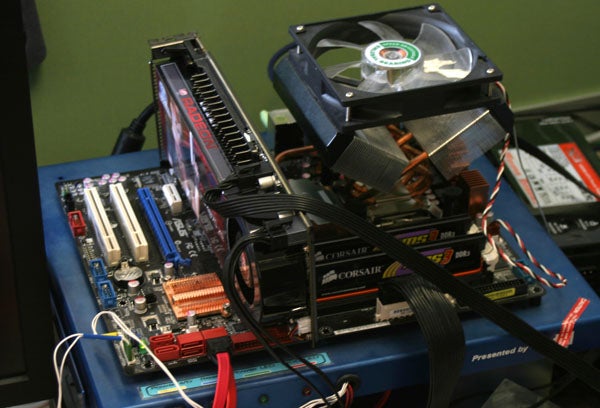
While it hasn’t been a huge commercial success and its gameplay is far from revolutionary, the graphical fidelity of Crysis is still second to none and as such it’s still the ultimate test for a graphics card. With masses of dynamic foliage, rolling mountain ranges, bright blue seas, and big explosions, this game has all the eye-candy you could wish for and then some.
We test using the 32-bit version of the game patched to version 1.1 and running in DirectX 10 mode. We use a custom timedemo that’s taken from the first moments at the start of the game, wandering around the beach. Surprisingly, considering its claustrophobic setting and graphically rich environment, we find that any frame rate above 30fps is about sufficient to play this game.
All in-game settings are set to high for our test runs and we test with both 0xAA and 4xAA. Transparency anti-aliasing is also manually turned on through the driver, though this is obviously only enabled when normal AA is being used in-game.
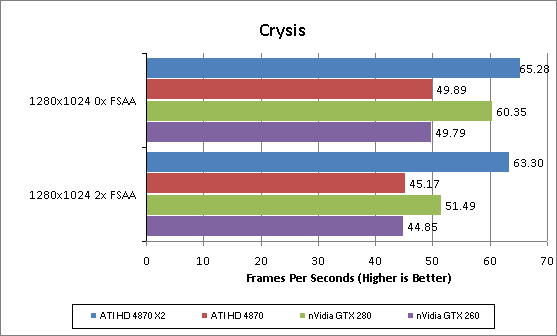
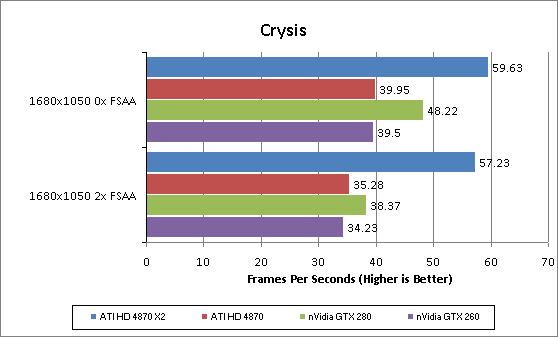
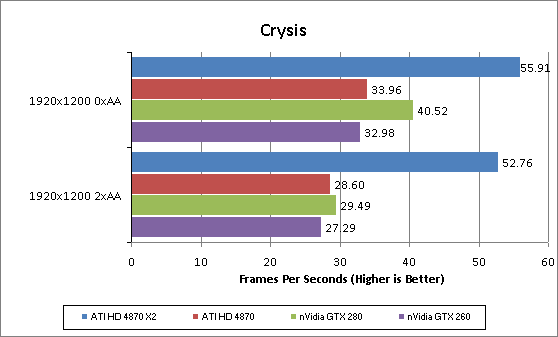
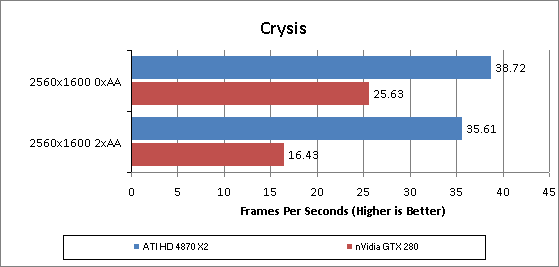
Even though ATI was at pains to point out Crysis is one game that doesn’t scale very well in Crossfire, the HD 4870 X2 still has a clear lead over any other single card. Indeed this card sets a record by being the first single card that gives playable frame rates at 2,560 x 1,600 in this game. Truly impressive stuff.
Enemy Territory: Quake Wars distinguishes itself from all our other tests by using the open source OpenGL API rather than Microsoft’s DirectX. It’s a team-based first person shooter set in a dystopian future war scenario. As a player you get to choose from an enormous range of character types and playing styles, as well as a whole host of vehicles. Battles can span vast areas of open space and involve a huge number of participants. All in all, it’s multiplayer heaven.
We test using the 32-bit version of the game, which is patched to version 1.4. We use a custom timedemo from the Valley level, which we feel is about as graphically intensive as the game gets. We feel a framerate of at least 50fps is required for this game as the intense multiplayer action and high speed mouse movement demands it.
All in-game settings are set to their maximum and we test with 0xAA 0xAF, 2xAA 4xAF, and 4xAA 8xAA. Transparency anti-aliasing is also manually turned on through the driver, though this is obviously only enabled when normal AA is being used in-game.
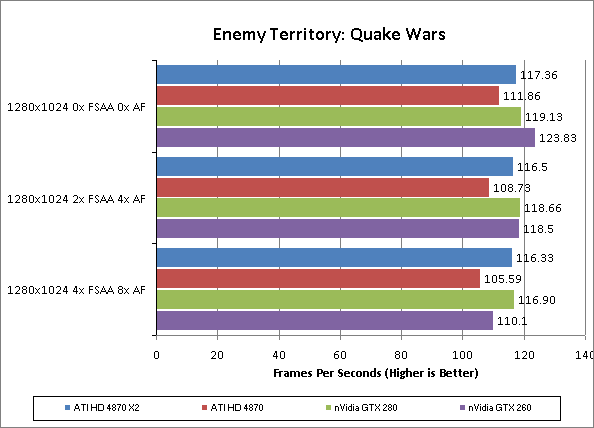
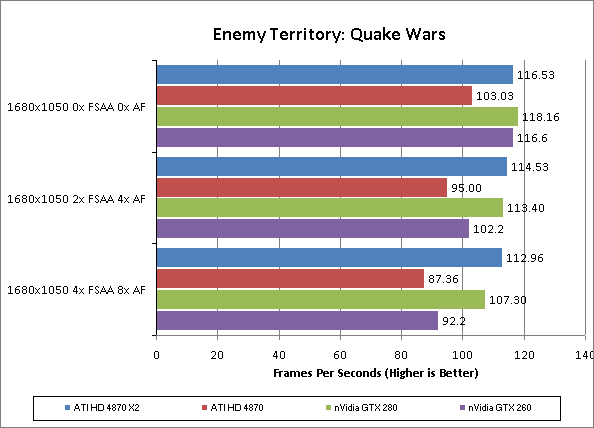
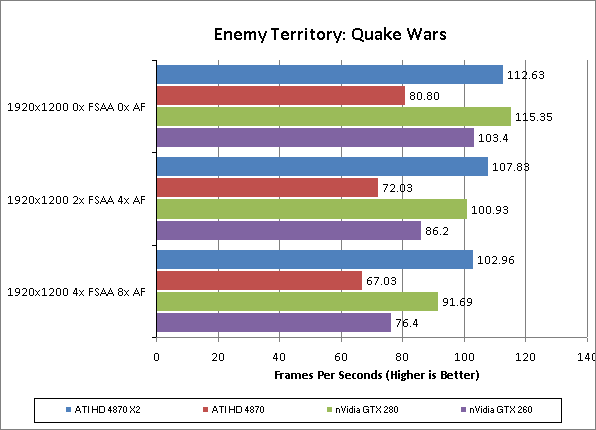
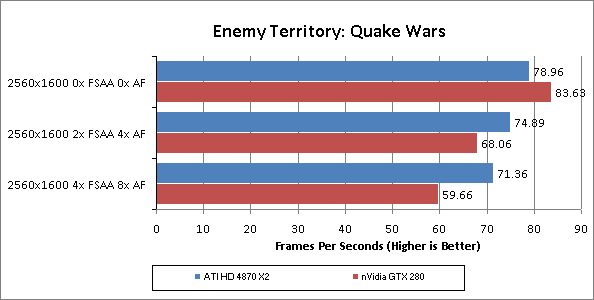
ATI has always struggled with games written using the OpenGL API so it’s no surprise to see its single-chip cards falling behind nVidia’s cards. However, for the HD 4870 X2 to scale quite so badly is something we didn’t expect. Yes it’s an improvement but based on this game alone you’d be better off getting an nVidia GTX 280.
Call of Duty 4 has to be one of our favourite games of last year. It brought the Call of Duty brand bang up to date and proved that first person shooters didn’t need to have the best graphics, or the longest game time. It was just eight hours of pure adrenaline rush that constantly kept you on edge.
We test using the 32-bit version of the game patched to version 1.4. FRAPS is used to record frame rates while we manually walk through a short section of the second level of the game. We find a frame rate of 30fps is quite sufficient because, although the atmosphere is intense, the gameplay is less so – it doesn’t hang on quick reactions and high-speed movement.
All in-game settings are set to their maximum and we test with 0xAA and 4xAF. Transparency anti-aliasing is also manually turned on through the driver, though this is obviously only enabled when normal AA is being used in-game.
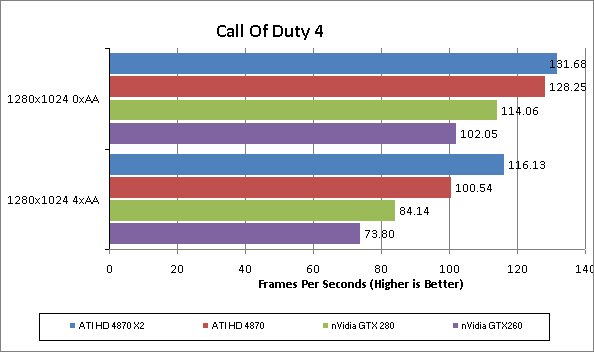
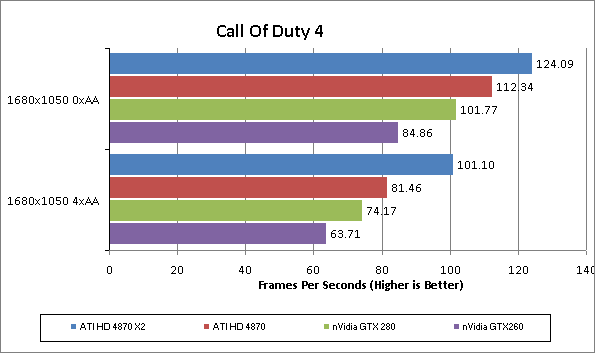
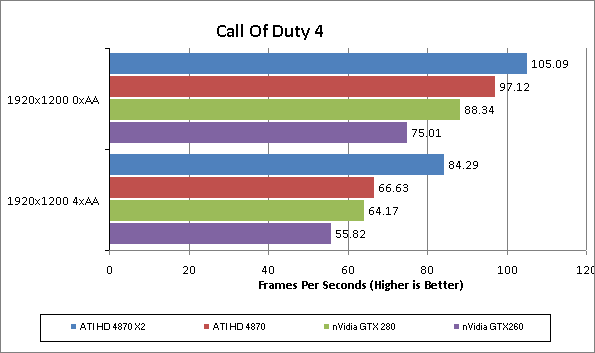
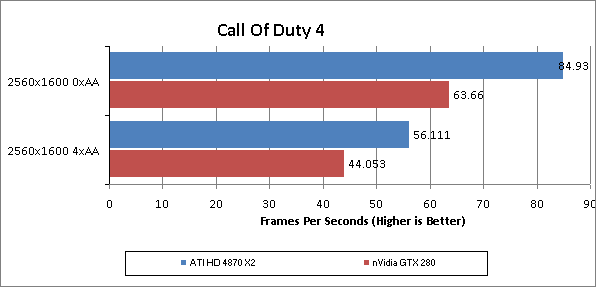
That’s more like it – the HD 4870 X2 takes and holds the lead throughout these tests. Again, the performance scaling isn’t amazing with the HD 4870 X2 only peaking at about 30 per cent faster than a single HD 4870. We’d struggle to recommend this card based on this game alone.
What can we say about Counter-Strike: Source that hasn’t already been said before? It is quite simply the benchmark for team-based online shooters and, four years after its release, it’s still one of the most popular games in its genre. In complete contrast to Enemy Territory: Quake Wars, it focuses on small environments and incredibly intensive small-scale battles with one-shot kills the order of the day. If you want to test all elements of your first person shooter skills in one go, this is the game to do it.
We test using the 32-bit version of the game using a custom timedemo taken during a game against bots on the cs_militia map. This has a large amount of foliage, so transparency antialiasing has a significant impact on image quality and performance, and is generally one of the most graphically intensive maps available. We find a frame rate of at least 60fps is required for serious gaming as this game relies massively on quick, accurate reactions that simply can’t be compromised by dropped frames.
All in-game settings are set to their maximum and we test with 0xAA 0xAF, 2xAA 4xAF, and 4xAA 8xAA. Transparency anti-aliasing is also manually turned on through the driver, though this is obviously only enabled when normal AA is being used in-game.
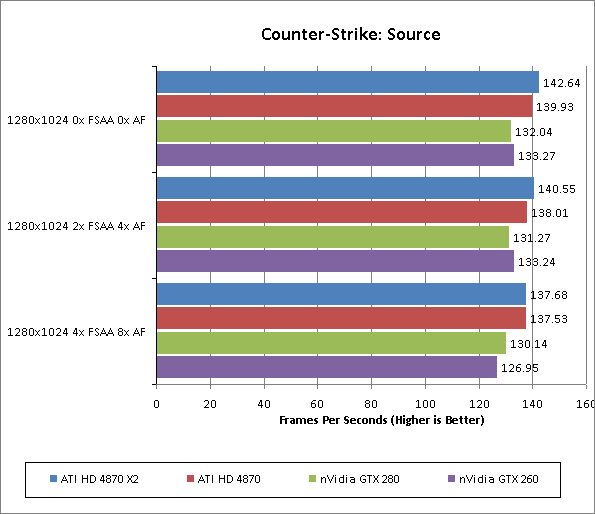
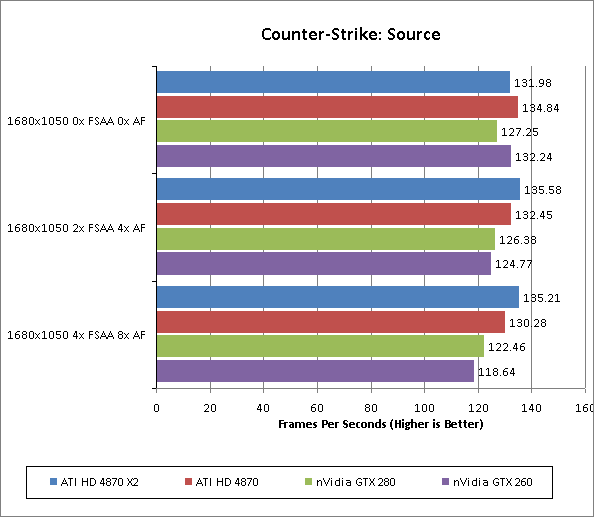
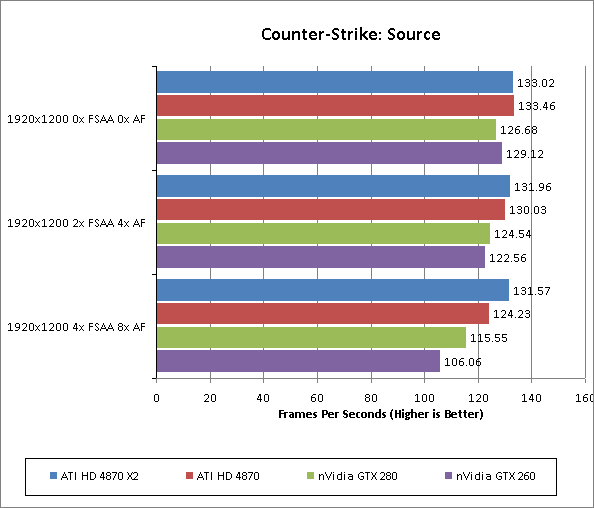
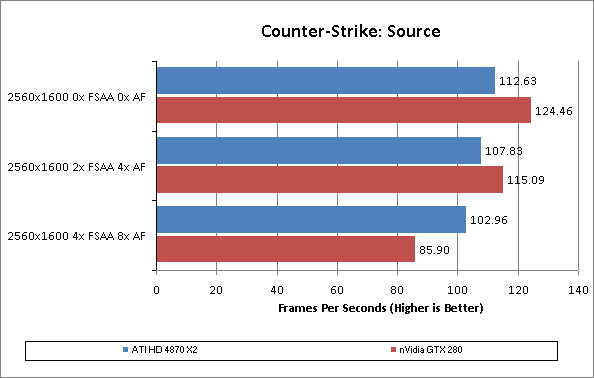
This game simply isn’t a challenge for any of these top end cards any more and even at the highest resolutions we’re largely CPU limited. With this in mind it would be unfair to draw too many conclusions about the performance of the HD4870 X2.
Race Driver: GRID is the newest game in our testing arsenal and it’s currently one of our favourites too. Its combination of arcade style thrills and spills with a healthy dose of realism and extras like Flashback makes it a great pick-up-and-go driving game. It’s also visually stunning with beautifully rendered settings, interactive crowds, destructible environments, and stunning lighting. All that and it’s not the most demanding game on hardware, either.
We test using the 32-bit version of the game, which is unpatched and running in DirectX 10 mode. FRAPS is used to record frame rates while we manually complete one circuit of the Okutama Grand Circuit, in a Pro Tuned race on normal difficulty. We find a frame rate of at least 40fps is required to play this game satisfactorily as significant stutters can ruin your timing and precision. We’d also consider 4xAA as a minimum as the track, barriers, and car bodies suffer considerably from aliasing and are a constant distraction.
All in-game settings are set to their maximum and we test with 0xAA, 4xAA, and 8xAA. Transparency anti-aliasing is also manually turned on through the driver, though this is obviously only enabled when normal AA is being used in-game.
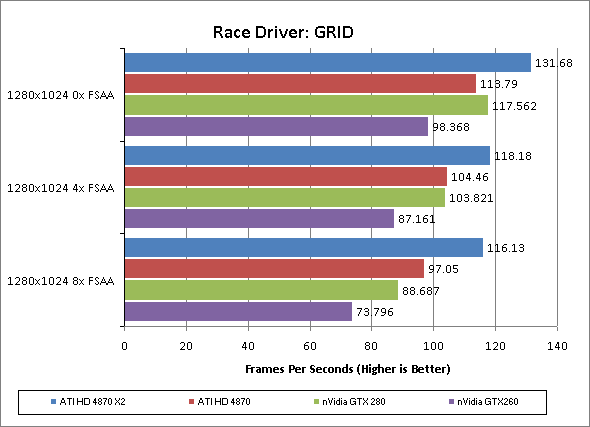
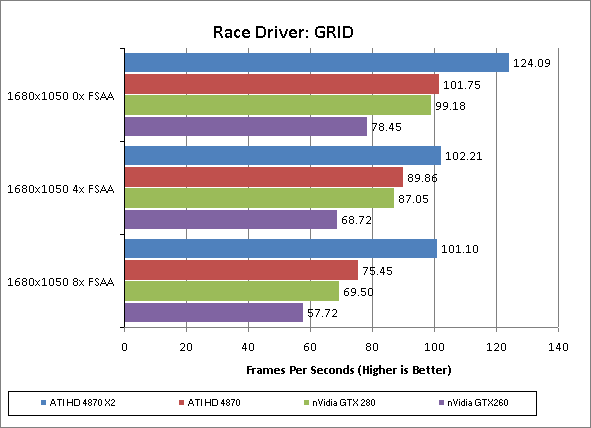
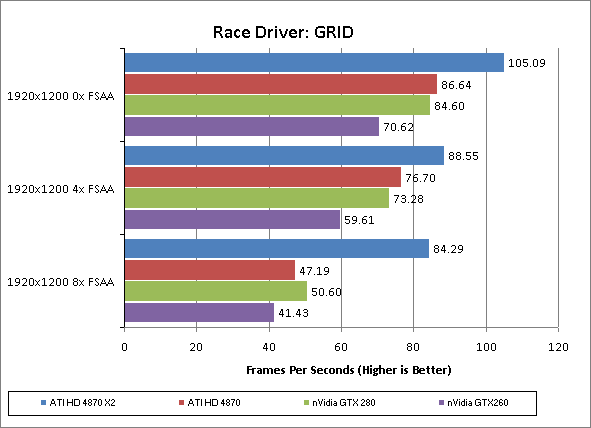
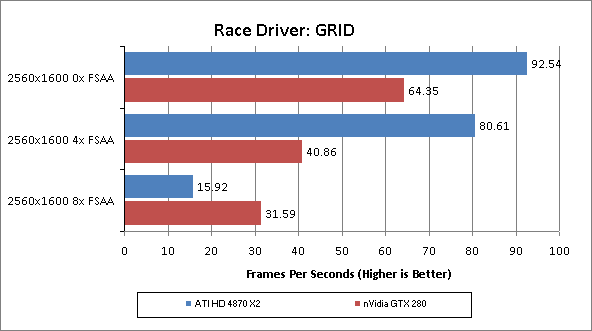
The HD 4870 X2’s poor result for 2,560 x 1,600, 8 x AA is something we’ve seen a few times before with this game. When detail settings and resolutions are pushed beyond a certain point, performance just plummets. The point at which this happens is different for every card but it consistently rears its head. What we’ve found, though, is that tweaking things just a little will bring that performance right back to where it should be so while you may not be able to get conventional 8xMSAA you may be able to use one of ATI’s Custom sampling filters and get much better performance.
As for overall performance, the HD 4870 X2 holds up very well. Although this game remains playable with most of the cards on test, the HD 4870 X2 manages to pull away at the most extreme settings, sometimes even doubling the performance of the GTX 280.
At idle, the HD 4870 X2 isn’t too power hungry. Even with the addition of a whole extra chip and 1,024MB of memory, it only draws 6 more Watts than a single HD 4870 and only 13 Watts more than a GTX 260. Undoubtedly impressive, which is more than you can say for power consumption when under load.
Now in fairness we test the power consumption of these cards when they’re running through our Crysis demo, as this is just about the most taxing test for any graphics card, so while the HD 4870 X2 does draw more power it is also giving more performance for that extra energy being consumed. Still, it’s quite an ”impressive” amount of extra power. 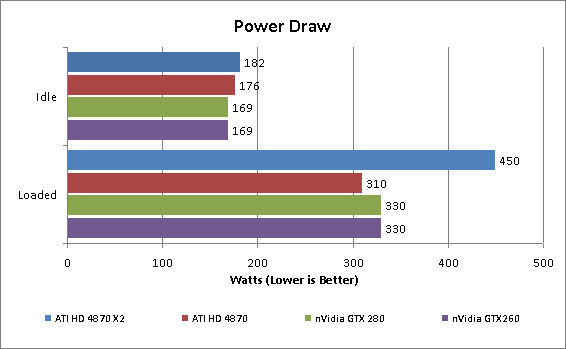
So, the HD 4870 X2 is definitely the fastest card we’ve ever tested and it worked flawlessly with all the games we tested. However, we can’t escape two familiar thoughts.
First, is the nagging doubt about the compatibility of this card with upcoming games. After all, if you spend £300+ on a graphics card, you expect a great gaming experience for a fair proportion of the foreseeable future. With any kind of multi-chip implementation – whether it be a conventional two or three card Crossfire/SLI setup or a two-chips on one card setup – there’s always a question mark hanging over future compatibility, often leaving you waiting for several weeks or months for the driver team or the game developer to release an update.
Second, is simply the case that apart from Crysis, you will only need this card if you’re playing at 2,560 x 1,600 or at 1,920 x 1,200 with very high antialiasing settings. Obviously this isn’t something that will influence our overall opinion of the card but it is definitely something to think about if you’re considering buying one.
Aside from this, though, we can have no significant complaints about this card. We still prefer the look and feel of nVidia’s cards but at least ATI has made a positive step in that direction by making the PCB black. The Peak power draw is also alarming but ultimately understandable. Even the odd orientation of the power connectors we can forgive. However, most importantly of all, is the price, which we think is just about right.
”’Verdict”’
ATI’s tactic of using multiple graphics chips on a single card to get the top performance may set our alarm bells ringing when it comes to compatibility issues. However, we experienced no problems and the price and performance of this card is undeniably great. All of which makes it thoroughly deserving of a recommended award.
Trusted Score
Score in detail
-
Value 7
-
Features 8
-
Performance 10

